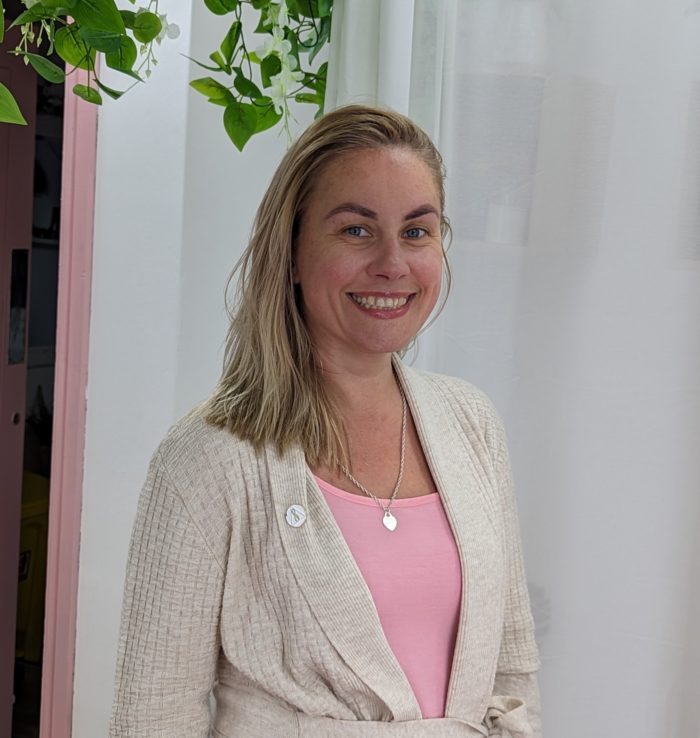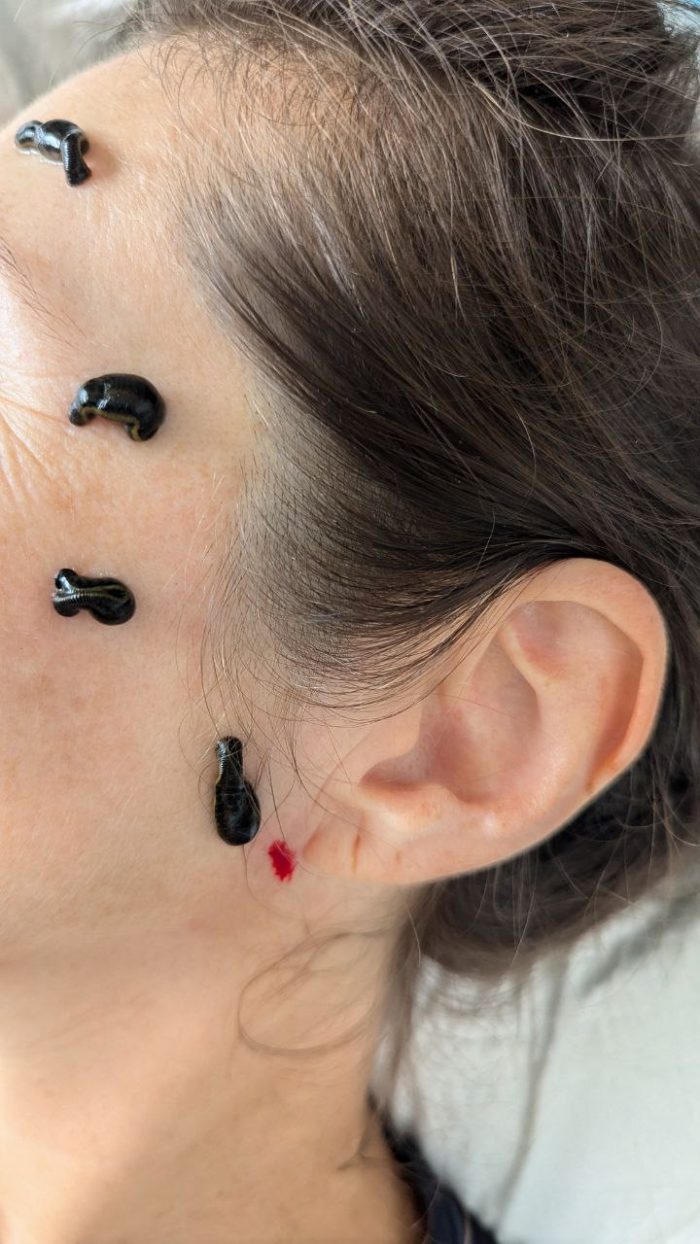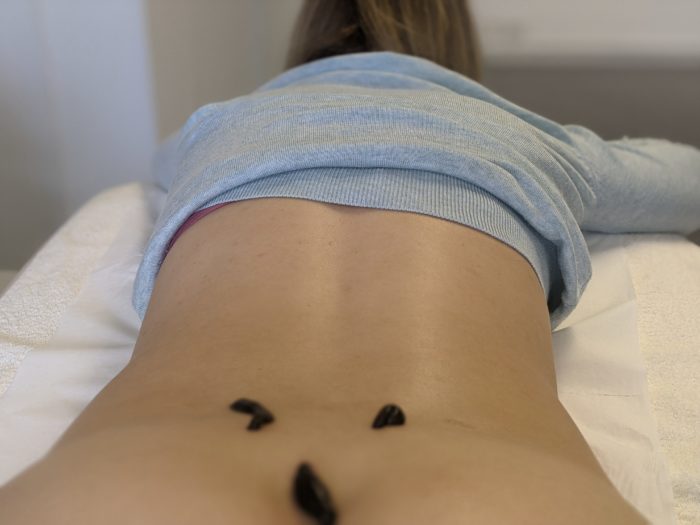
Leech therapy – Tatiana Ferapontova owes her health to it
An old therapy that research is bringing back to modern usage.
“You can’t have kids” – Tatiana Ferapontova was told all her life.
Her family suffers from a disease of the vascular system. But here she is, never the less, with two daughters. How is this? And what unusual therapies were part of her journey to wellness – and now part of Tatiana’s life.
Tatiana grew up on an Russian Island by Japan with an engineer father from Germany who worked in Japan. What she learnt in the school there and their approach to education has influenced her whole thinking and life. On the Island she studied advanced maths, physics, Japanese and Korean. At 12, her life changed because the school talked about waves and frequencies – it has led her and her friends to talk differently and react differently for the rest of their lives.
In the mean time, her vascular disease was so severe that she could not get up from bed with a bandage on her left leg. She has had numerous operations. Married and seeing herself as a mum, she kept trying for children, despite the dangers to her. Using a lot of supplements, studying, taking many drugs, she managed at last to have a baby (a water birth) in London. It was, she says ‘very difficult’.
So she went for another child, despite being warned of the threat to life. She gave birth and promptly had a stroke. She now believes that having the second baby in water would have reduced blood pressure and avoided the stroke.
Tatiana’s life now included a huge amount of pharmaceutical drugs – as a relatively young woman, she could became away of the side effects on her live, kidneys and vascular system. Through researching therapies that could help after strokes, she embarked on a course of therapy with a leech therapist (see box for research into the modern application of leeches in therapeutic settings).
She made progress using the therapy but then her therapist moved abroad. So as to enable Tatiana to continue with the therapy, she suggested that Tatiana train and treat herself.
Although daunted, Tatiana began to progress to running a leech therapy practice. In her early 30s, she was working with much older clients. “I was very scared!”. In addition to leech therapy, she studied naturopathy and pharmacology to better serve her clients and understand the drug regimens they were on. Driven by a determination to do her best, her first clients tended to come for rehabilitation after strokes and TIAs. People also came for detoxification.
With more women having problems becoming pregnant, they also began to become clients to support their efforts with IVF – either for detoxing their system or to help with endocrine imbalances that were affecting them.

Other clients come for leech therapy facials.
Reflecting on what we does she sums up the effect of leech therapy “It’s like our body is sleeping, either because it is ‘dirty’ or for another reason. It needs “unblocking”. Tatiana feels the leeches also work on the human energy system.
She gives some examples of clients: a woman in her mid 20s with Hashimoto’s disease (autoimmune). She couldn’t get pregnant. The client was optimistic, Tatiana was not. It took eighteen months to two years, but she got pregnant and become the mum to a baby girl.
Highlighting the importance of access to naturopathic training as well, Tatiana talks about a man in his 50s. He had worked in a chemical production facility. When his protective equipment failed, he ended up in intensive care with major damage to his lungs and liver and 50% function in one kidney. His skin was falling apart ‘like a snake’ and he had resorted to buying tshirts in bulk which were thrown away after one usage.
Using supplementation as well, her client recovered and his health changed significantly. Tatiana taught him how to apply leeches when he was not able to attend.
“Most of the time” says Tatiana, “we need to start with the lymphatic system. It’s like a blockage in a house in a kitchen. You know your sink is blocked. You don’t take the sink apart, you find the causal blockage, clean it from there and only then return to the sink.”
Clients are sometimes surprised that the first time they come that only one leech is used. Leeches take between 2ml and 10ml of blood. You can’t share leeches between people, so Tatiana’s solution is to have people buy their leeches from a trusted source and look after them between sessions – they have to be looked after carefully. She has a great fondness for her tiny helpers, seeing them as active collaborators in the sessions. It’s just another reason why she tries to encourage people to avoid junk food. Sometimes leeches are so affected by what is in the blood of clients, they will die within 24 hours unfortunately. At 15, Tatiana was at university studying organic living and knows the side effects of poor food.
Explaining what it feels like to have leech therapy, Tatiana says “people just feel very very warm after the initial ‘bite’. When a leech has had enough, it falls off – and it is better to leave it until this happens, as they supply more chemicals to the body this way and the ‘bite’ heals better.”
People’s attitudes towards them tend to change with more treatment, one of Tatiana’s clients now calls them ‘our friends’.
Leech therapy research
Leech therapy, also known as hirudotherapy, has been used for centuries to treat various medical conditions. Recent research has focused on the therapeutic potential of leech saliva, which contains bioactive substances with anti-inflammatory, anticoagulant, and anesthetic properties. Here’s a summary of key findings:

Modes of Action
- Analgesic and anti-inflammatory effect: Substances like antistasin, hirustasin, and eglin C have been identified as potent analgesics and anti-inflammatory agents.
- Extracellular matrix degradation: Enzymes like hyaluronidase and collagenase facilitate tissue remodeling and promote wound healing.
- Increasing blood flow: Acetylcholine and histamine-like molecules improve blood circulation and reduce edema.
4. Inhibition of platelet function: Saratin, calin, and apyrase inhibit platelet aggregation, preventing blood clotting and thrombosis.
5. Anticoagulant effect: Hirudin, gelin, and factor Xa inhibitors prevent blood coagulation, reducing the risk of thrombosis and embolism.
6. Antimicrobial effect: Substances like destabilase and chloromycetyn exhibit antimicrobial properties, reducing the risk of infection.
Clinical Applications
- Osteoarthritis: Leech therapy has shown promise in reducing symptoms and improving joint function in patients with osteoarthritis.
- Vascular disorders: Leech therapy has been used to treat chronic venous insufficiency, post-phlebitic syndrome, and inflammatory skin diseases.
- Surgical applications: Leeches are used to promote blood flow and reduce edema in reconstructive surgery, particularly in cases of flap necrosis.
- Pain management: Leech therapy has been used to provide pain relief, particularly in cases of chronic pain and neuropathic pain.
Recent Studies
- A 2021 study published in the Journal of Leech Therapy found that leech therapy significantly improved sperm parameters and reduced testicular damage in an animal model.
- A 2020 review published in the European Journal of Integrative Medicine highlighted the potential of medicinal leech therapy in treating inflammatory diseases, osteoarthritis, and post-surgical pain.
- A 2013 study published in the Journal of Ethnopharmacology investigated the bioactive compounds present in leech saliva and their potential therapeutic applications.
Challenges and Future Directions
- Standardization: There is a need for standardized protocols for leech therapy, including leech species, preparation, and application methods.
- Regulatory frameworks: Regulatory bodies need to establish guidelines for the use of leech therapy in clinical settings.
- Large-scale clinical trials: Further large-scale clinical trials are necessary to confirm the efficacy and safety of leech therapy for various indications.
Overall, leech therapy research has made significant progress in recent years, highlighting the potential therapeutic benefits of leech saliva and its bioactive compounds. However, further studies are needed to fully understand the mechanisms of action and to establish leech therapy as a viable treatment option for various medical conditions.
(Source: Brave AI)
To find out more about leech therapy or connect with Tatiana
Tel: 07741277190
Email: fortruestyle@gmail.com
Web: www.fortruestyle.co.uk